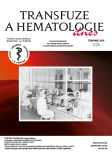Imprint lymph node cytology: 11 years old experience
Authors:
A. Wild 1,2; J. Holasová 1,2; L. Plank 3,4; P. Szépe 3,4; T. Balhárek 3,4; J. Marcinek 3,4
Authors‘ workplace:
Hematologické oddelenie a Centrálny laboratórny komplex FNsP F. D. Roosevelta v Banskej Bystrici
1; LF SZU v Bratislave
2; Ústav patologickej anatómie, Jesseniova lekárska fakulta UK a Martinská univerzitná nemocnica v Martine
3; Martinské bioptické centrum, s. r. o. v Martine
4
Published in:
Transfuze Hematol. dnes,25, 2019, No. 2, p. 176-185.
Category:
Original Papers
Overview
Aims: Lymphatic node imprint cytology has been performed at the authors´ institution over a long period of time and has been used for further diagnosis, staging or starting treatment before histology is available as well as for fluorescent in-situ hybridization genetic testing. The aim of this study is to assess diagnostic reliability of cytology.
Results: The authors analysed retrospectively 122 samples that could be compared with histology findings. Five imprints were not representative. Overall sensitivity, specificity, positive and negative predictive value and diagnostic accuracy were 67, 69, 85, 44 and 67% respectively. The lowest sensitivity of 36% was found in the group of low grade non-Hodgkin's lymphomas with other malignancies demonstrating 77% sensitivity. Specificity for metastases of non-haematology tumours was 100%. The authors identified 7 cases where treatment was started before histology results were available, of which five cases had correct cytology results. The causes of incorrect diagnostics were: similar or identical monomorphic infiltration with basophilic vacuolised blasts often associated with macrophages in various blastic lymphomas and metastases; cohesive clumps of tumour cells in lymphomas; similarity of physiological and lymphoma lymphocytes; similarity of Hodgkin and Sternberg-Reed cells and cells in non-Hodgkin's lymphomas and metastases, frequently with a reactive background population. Proliferation of eosinophils was found only in 40% of Hodgkin's lymphomas.
Conclusion: Cytology does not have absolute diagnostic accuracy when determining the type of malignancy, except for an absolute specificity for unequivocal metastatic infiltration. Cytology results may be used for early staging. In the emergency setting, a clinician may use cytology results before histology findings are available for targeted cytoreductive treatment that can reverse tumour compression of organs or even prevent progressive malignant cachexia and worsening of overall patient performance status due to very aggressive tumours, which could limit intensive antineoplastic therapy once the diagnosis is definitive.
Keywords:
cytology – lymph node – lymphadenopathy – imprint
Sources
1. Arif SH, Hassan MJ, Jain M, Verna AK, Naim M. Role of imprint cytology in diagnosis of lymph node lesions. Indian Med Gazette 2011;145(10):385–390.
2. Molyneuax AJ, Attanoos RL, Coghill SB. The value of lymph node imprint cytodiagnosis – an assessment of inter observer agreement and diagnostic accuracy. Cytopathol 1997;8(4):256–264.
3. Tiwari G, Rane V D, Bansal R, Sharma S, Khare A. Touch imprint cytology and its correlation with histomorphologic findings in lymphadenopathies. Int J Curr Res 2015;7(4): 15078–15080.
4. Luqman M, Jafarey NA. Imprint cytology of lymph nodes 1980;30(12):266–267.
5. Al-Mulhim AS, Al-Ghamdi AMA, Al-Marzooq YM, et al. The role of fine needle aspiration cytology and imprint cytology in cervical lymphadenopathy. Saudi Med J 2004;25(7):862–865.
6. Patra SP, Bhattacharya N, Maugal S. FNAC, Imprint cytology and histopathology for diagnosing diseases of lymph node. J Cytol 2003;20(3):124–128.
7. Kundu P, Pathak D, Mondal S, Debnath M, Saha S, Saha T K. Histopathological correlation of lymph nodes imprints. Journal of dental and medical sciences 2015;14(11):101–105.
8. El-Sayed AM, El-Borai MH, Bahnassy AA, El-Gerzawi SMS. Flow cytometric immunophenotyping (FCI) of lymphoma: correlation with histopathology and immunohistochemistry. Diag Pathol 2008;3:43.
9. Cozzolino I, Rocco M, Villani G, Picardi M. Lymph node fine-needle cytology of non-Hodgkin lymphoma: diagnosis and classification by flow-cytometry. Acta Cytol 2016;60(4):302–314.
10. Barroca H, Marques C. A basic approach to lymph node and flow cytometry fine-needle cytology. Acta Cytol 2016;60(4):284–301.
Labels
Haematology Internal medicine Clinical oncologyArticle was published in
Transfusion and Haematology Today

2019 Issue 2
Most read in this issue
- Haematopoietic stem cell transplantation in patients with myelodysplastic syndrome – a single centre experience
- Overview of malignant disorders derived from the histiocytic and dendritic cells
- Imprint lymph node cytology: 11 years old experience
- Analysis of blood donor fluctuation between state-run transfusion centres and private plasma donation centres
